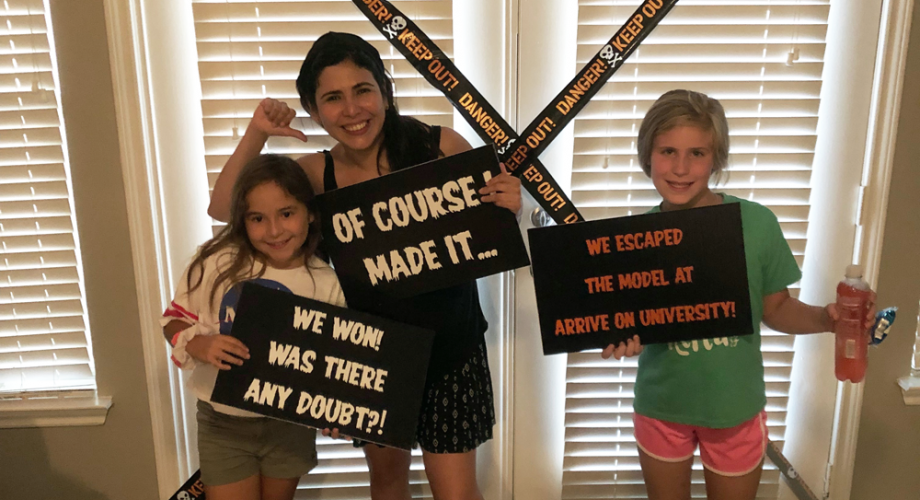With Halloween approaching, one Texas community decided to add an escape room to its onsite attractions.
DeAnna Seward became interested in escape rooms years ago. In fact, the Trinity Property Consultants Area Manager liked the experience, which entails being locked in a room and given a set of clues or tasks to engineer an escape, so much that she bought a bunch of locks to create her own escape room at her community. During a recent brainstorming session to plan October’s resident events with her team at the 180-unit Arrive on University in Dallas, Seward saw an opportunity to finally create such a space as an apartment community amenity.
“Aliya Sultan, my leasing consultant, was like, ‘Let’s do a haunted house,’ and it just triggered something in my mind,” says Seward. “I had a room available, and now is the perfect time [of the year, with Halloween approaching] to do it. I had an opportunity to be with a company that would allow it, and it was our slow season here because most of the student population has moved in already.”
Arrive on University isn’t a traditional student community, but it is near Southern Methodist University, and about 30 percent of its residents are students.
“We wanted to generate some different kind of traffic, and then we usually try to do two to four events a month for our residents,” Seward says. “[The safe room] was an opportunity to bring something new to them. We also decided to open it up to the public to create that traffic.”
Before designing the room, Seward took her team members to another escape room. “It’s really hard to build one without having ever been to one,” she says. “Some members of my team had never been in an escape room. So, we closed the office down, went to an escape room and had a ball with it.”
With that experience behind it, Seward’s team was ready to create its own escape room. But first, it needed to create a theme. “I think the hardest thing was to actually figure out what the story was going to be,” she says. “You have to figure out the point and purpose of escaping and what [the participants] are escaping from.”
Seward and her team eventually came up with a Halloween theme that was a little “soft” but still fun. “We initially had the word ‘haunted’ in the theme, but we felt like people might think it was a really scary thing,” Seward says. “So, we took that word out. The only scary thing in there were [literally] the skeletons in the closet, but it was really fun to do.”
To create the “room”—which occupied an entire apartment—Seward’s team removed one regular lightbulb in each room and replaced it with a purple or red bulb. To escape, participants needed to locate clues and keys throughout the apartment, like decoding a dominoes game or using a black light to find hints written on the wall in invisible ink.
“We placed five Scrabble pieces in the escape room which spelled out the name of the ‘trapped spirit,’” Seward says. “Once the name was discovered, it allowed a box to be opened that revealed clues to the final key to unlock the [apartment]. The Assistant Manager, Elizabeth Alby, created a fictional storybook that was strategically placed on the bed signed by Codie, the name of the trapped spirit, so that there was more than one way to reveal his name.”
The team placed a very important key inside a shadow box in such a way that the key could be removed only by using a magnet to lift it to the top of the box to be retrieved and used to solve another important piece of the puzzle.
“Throughout the apartment, we [also] placed several fake clues that were intended to throw the participants off their game, essentially making it harder to escape, such as a dartboard with darts strategically placed on four different numbers which could be mistaken for a clue,” Seward says.
Once the escape room was set up, Seward’s team did a test run, which revealed that 30 minutes was the right amount of time to allow residents and prospects to explore the amenity.
“Most escape rooms [take] an hour [to get through],” Seward says. “We didn’t feel like we could do an hour, just because of the number of hours in our day and that you have to set up the room [after each use], which takes anywhere from 15 to 20 minutes,” Seward says.
Overwhelming Response
The escape room generated a year-over-year increase and drew a lot of online attention from Seward’s industry colleagues. “I think sharing the excitement and fun with industry folks was the most rewarding [aspect of the amenity], because everyone was loving it,” she says.
Seward says she replied to so many messages on Facebook about the promotion that she was blocked from sending messages for three days. “We’ve had multiple participants already,” she says. “It’s been fun.”
Even if the escape room hadn’t resonated so well with residents and prospects, Seward says, she sees another, perhaps equally important reason for its creation: “It was great for team building,” she says.
